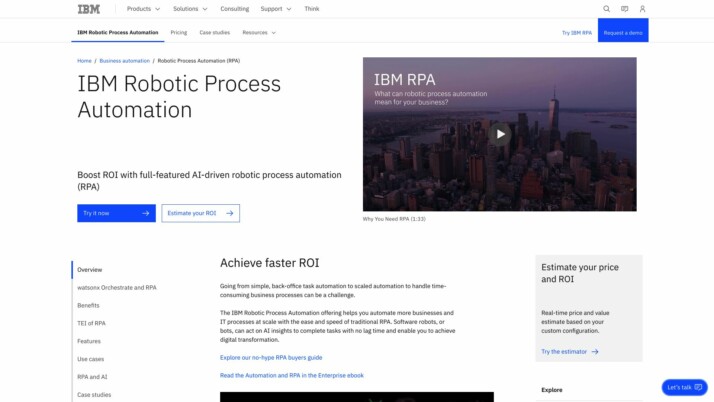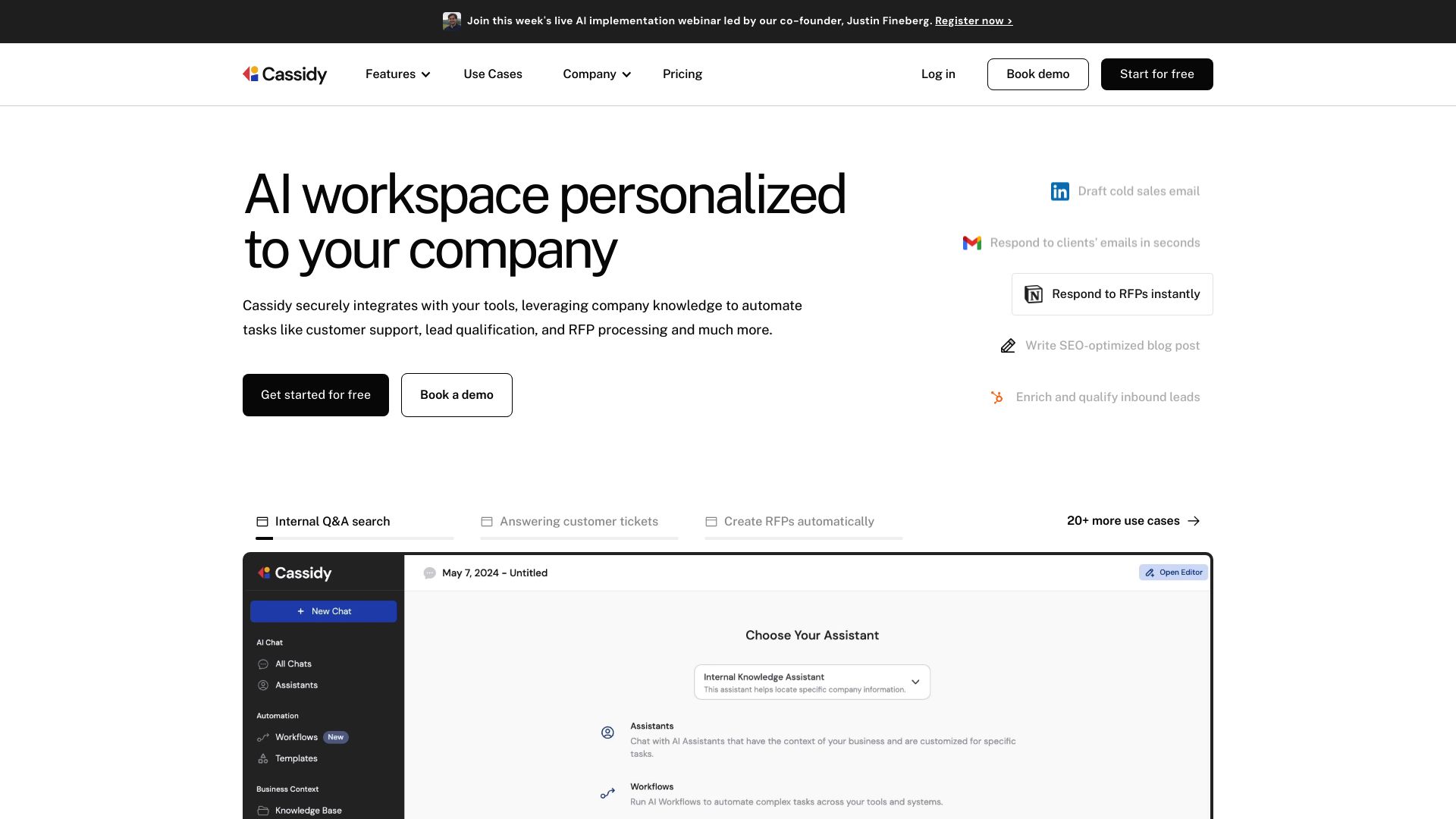IBM RPA vs. Cassidy: Enterprise Features and Customization Compared
AI automation platforms revolutionize how businesses operate, but choosing the right solution can be daunting. This comparison delves into IBM RPA vs. Cassidy, and SmythOS, three leading contenders in the AI automation space. We examine their core features, integration capabilities, and user experiences to help you make an informed decision.
Whether you’re a developer seeking powerful APIs, a business leader focused on scalability and compliance, or a non-technical user looking for accessible AI tools, this review provides insights tailored to your needs. Discover how each platform tackles enterprise-grade automation, customization flexibility, and the democratization of AI technology.
IBM RPA Overview
IBM Robotic Process Automation (RPA) empowers organizations to automate repetitive tasks across enterprise systems. The platform combines AI-powered automation with low-code tools, enabling both technical and business users to create software bots that streamline operations.


IBM RPA’s core offering centers on building, deploying, and managing intelligent bots. These bots can interact with user interfaces, APIs, and backend systems to execute complex workflows autonomously. The platform’s visual builder simplifies bot creation through drag-and-drop functionality, while more advanced users can leverage coding capabilities for customization.
IBM RPA excels in enterprise-grade features. Its scalable architecture supports concurrent bot execution, allowing organizations to automate at scale.
IBM RPA excels in enterprise-grade features. Its scalable architecture supports concurrent bot execution, allowing organizations to automate at scale. Integration with IBM watsonx Orchestrate enhances bots with AI-driven decision-making and natural language processing. Security and compliance are prioritized through features like data encryption and audit logging.
While IBM RPA offers robust capabilities, its enterprise focus may present a steeper learning curve for smaller organizations or individual users. The platform’s pricing structure and deployment options cater primarily to large-scale implementations, potentially limiting accessibility for smaller projects.
IBM RPA’s strengths lie in its seamless integration with existing enterprise systems, strong governance features, and ability to handle complex, multi-step processes. However, users seeking a more lightweight solution or extensive pre-built templates for specific industries might find the platform’s comprehensive nature overwhelming.
Cassidy Overview
Cassidy specializes in creating AI automations and assistants tailored to specific business needs. The platform securely integrates with existing tools and leverages company knowledge to automate tasks like customer support, lead qualification, and RFP processing. This personalization enhances productivity by equipping AI assistants and workflows with full context specific to each business.
Cassidy specializes in creating AI automations and assistants tailored to specific business needs. The platform securely integrates with existing tools and leverages company knowledge to automate tasks…


Cassidy’s platform stands out with its model-agnostic approach, allowing users to employ any foundational AI model. This flexibility future-proofs AI strategies and adapts to evolving business needs. The platform seamlessly integrates with various data sources, including Google Drive, Slack, and Notion, enabling comprehensive data utilization.
Cassidy’s platform stands out with its model-agnostic approach, allowing users to employ any foundational AI model. This flexibility future-proofs AI strategies and adapts to evolving business needs.
Security remains a top priority for Cassidy. The platform ensures data confidentiality by never using client data for model training, addressing crucial privacy concerns for businesses handling sensitive information. Cassidy also offers a user-friendly workflow builder with a no-code, drag-and-drop interface, empowering users to create complex AI automations without extensive technical expertise.
While Cassidy provides powerful features, users may face challenges in scaling operations for larger enterprises or integrating with legacy systems. The platform’s focus on customization and ease of use may come at the cost of advanced functionalities required by highly technical users. Additionally, the pricing structure might not be as transparent or flexible as some competitors, potentially limiting accessibility for smaller businesses or individual developers.
Cassidy’s vision centers on improving AI adoption in businesses by making it accessible to non-technical users. The platform aims to empower all employees, regardless of technical background, to harness AI for enhancing productivity and operational efficiency. This approach aligns well with the growing trend of AI democratization but may not fully satisfy the needs of organizations requiring more specialized or complex AI implementations.
Feature Comparison
IBM RPA and Cassidy offer robust AI automation capabilities, but significant feature gaps exist between the platforms. IBM RPA excels in enterprise-grade features and scalability, while Cassidy focuses on customization and ease of use for businesses of all sizes.
In core components, IBM RPA provides a comprehensive suite of tools for building, deploying, and managing bots at scale. Its visual builder and low-code authoring tools enable both technical and non-technical users to create automations. However, Cassidy’s model-agnostic approach allows for greater flexibility in AI model selection, potentially future-proofing AI strategies more effectively than IBM’s offering.
Security-wise, IBM RPA integrates with IBM OpenPages for governance and compliance, offering enterprise-level data encryption and audit logging. Cassidy emphasizes data confidentiality by never using client data for model training, but lacks the extensive governance tools IBM provides. This gap may be significant for highly regulated industries requiring robust compliance measures.
While both platforms support API integrations, IBM RPA’s enterprise focus results in more comprehensive integration capabilities with legacy systems and enterprise applications. Cassidy’s Chrome Extension brings AI capabilities directly into web applications, a feature IBM RPA lacks. This difference highlights Cassidy’s emphasis on user-friendly, accessible AI tools versus IBM’s focus on complex, large-scale automations.
We’ve designed SmythOS to bridge these gaps, offering enterprise-grade security and scalability alongside user-friendly tools and flexible AI model integration. Our platform combines the strengths of both approaches, providing a comprehensive solution for businesses of all sizes.
Feature Comparison Table
| IBM RPA | Cassidy | SmythOS | |
|---|---|---|---|
| CORE FEATURES | |||
| AI Agents | ❌ | ✅ | ✅ |
| Memory & Context | ❌ | ✅ | ✅ |
| Autonomous Agents | ❌ | ❌ | ✅ |
| Explainability & Transparency | ❌ | ❌ | ✅ |
| Multimodal | ❌ | ❌ | ✅ |
| Problem-Solving Capabilities | ❌ | ✅ | ✅ |
| Multi-Agent Collaboration | ❌ | ❌ | ✅ |
| Audit Logs for Analytics | ✅ | ❌ | ✅ |
| Work as Team | ❌ | ✅ | ✅ |
| SECURITY | |||
| Constrained Alignment | ❌ | ✅ | ✅ |
| OAuth | ❌ | ✅ | ✅ |
| IP Control | ❌ | ❌ | ✅ |
| COMPONENTS | |||
| Foundation AIs | ❌ | ✅ | ✅ |
| Huggingface AIs | ❌ | ❌ | ✅ |
| Zapier APIs | ❌ | ✅ | ✅ |
| Classifiers | ❌ | ❌ | ✅ |
| Data Lakes | ❌ | ❌ | ✅ |
| DEPLOYMENT OPTIONS (EMBODIMENTS) | |||
| Deploy as Webhook | ❌ | ✅ | ✅ |
| Staging Domains | ❌ | ❌ | ✅ |
| Production Domains | ❌ | ❌ | ✅ |
| API Authentication (OAuth + Key) | ❌ | ❌ | ✅ |
| Deploy as Site Chat | ❌ | ❌ | ✅ |
| Deploy as GPT | ❌ | ❌ | ✅ |
| DATA LAKE SUPPORT | |||
| Hosted Vector Database | ❌ | ❌ | ✅ |
| Sitemap Crawler | ❌ | ❌ | ✅ |
| YouTube Transcript Crawler | ❌ | ❌ | ✅ |
| URL Crawler | ❌ | ❌ | ✅ |
Best Alternative to IBM RPA and Cassidy
SmythOS emerges as the superior alternative to IBM RPA and Cassidy, offering a comprehensive agentic AI automation platform that combines the strengths of both competitors while addressing their limitations. Our platform’s intuitive drag-and-drop interface empowers users to create sophisticated AI agents without extensive coding knowledge, democratizing AI development across organizations.
Unlike IBM RPA’s focus on repetitive task automation, SmythOS enables the creation of intelligent, autonomous agents capable of complex problem-solving and decision-making. We surpass Cassidy’s customization capabilities by supporting a wide range of AI models and providing seamless integration with various data sources and APIs. This flexibility allows businesses to tailor AI solutions to their specific needs while future-proofing their AI strategies.
SmythOS enables the creation of intelligent, autonomous agents capable of complex problem-solving and decision-making. We surpass Cassidy’s customization capabilities by supporting a wide range of AI models and providing seamless integration
SmythOS excels in scalability and deployment options, offering hosted environments for both development and production. Our platform supports multi-agent collaboration, enabling teams of AI agents to work together on complex tasks, a feature lacking in both IBM RPA and Cassidy. Additionally, SmythOS provides robust security measures, including data encryption and OAuth authentication, ensuring enterprise-grade protection for sensitive information.
We pride ourselves on our platform’s versatility, supporting a wide range of deployment options including APIs, webhooks, site chats, and even integration with popular AI platforms like ChatGPT. This flexibility, combined with our extensive data lake support and advanced features like hosted vector databases and multimodal capabilities, positions SmythOS as the ideal choice for businesses seeking a comprehensive, future-proof AI automation solution.
By choosing SmythOS, organizations gain access to a powerful, user-friendly platform that accelerates AI development, enhances productivity, and drives innovation across industries. Our solution bridges the gap between enterprise-grade functionality and accessibility, making advanced AI capabilities available to businesses of all sizes.
Conclusion
IBM RPA, Cassidy, and SmythOS each offer unique approaches to AI automation, catering to different business needs and technical expertise levels. IBM RPA excels in enterprise-grade features and scalability, making it suitable for large organizations with complex automation requirements. Cassidy focuses on customization and ease of use, appealing to businesses seeking tailored AI solutions without extensive technical knowledge.
While both platforms have their strengths, SmythOS emerges as the superior choice, combining the best aspects of enterprise-grade capabilities and user-friendly design. Our platform’s drag-and-drop interface and extensive integration ecosystem (with over 300,000 integrations) make it accessible to users of all technical backgrounds. Unlike IBM RPA’s steep learning curve or Cassidy’s potential limitations in scaling, SmythOS offers unparalleled flexibility and scalability.
SmythOS stands out with its “Create Once, Deploy Anywhere” approach, allowing users to build AI agents that seamlessly integrate across multiple environments. This versatility, coupled with our support for various AI models and pre-built templates, enables businesses to innovate rapidly and efficiently. Our platform’s emphasis on multi-agent collaboration and problem-solving capabilities surpasses the offerings of both IBM RPA and Cassidy.
We invite you to experience the future of AI automation with SmythOS. Explore our diverse range of AI-powered agent templates to jumpstart your projects, or create a free SmythOS account to build unlimited AI agents at no cost. Discover how SmythOS can revolutionize your workflow and unleash your business’s full AI potential today.
Last updated:
Disclaimer: The information presented in this article is for general informational purposes only and is provided as is. While we strive to keep the content up-to-date and accurate, we make no representations or warranties of any kind, express or implied, about the completeness, accuracy, reliability, suitability, or availability of the information contained in this article.
Any reliance you place on such information is strictly at your own risk. We reserve the right to make additions, deletions, or modifications to the contents of this article at any time without prior notice.
In no event will we be liable for any loss or damage including without limitation, indirect or consequential loss or damage, or any loss or damage whatsoever arising from loss of data, profits, or any other loss not specified herein arising out of, or in connection with, the use of this article.
Despite our best efforts, this article may contain oversights, errors, or omissions. If you notice any inaccuracies or have concerns about the content, please report them through our content feedback form. Your input helps us maintain the quality and reliability of our information.
